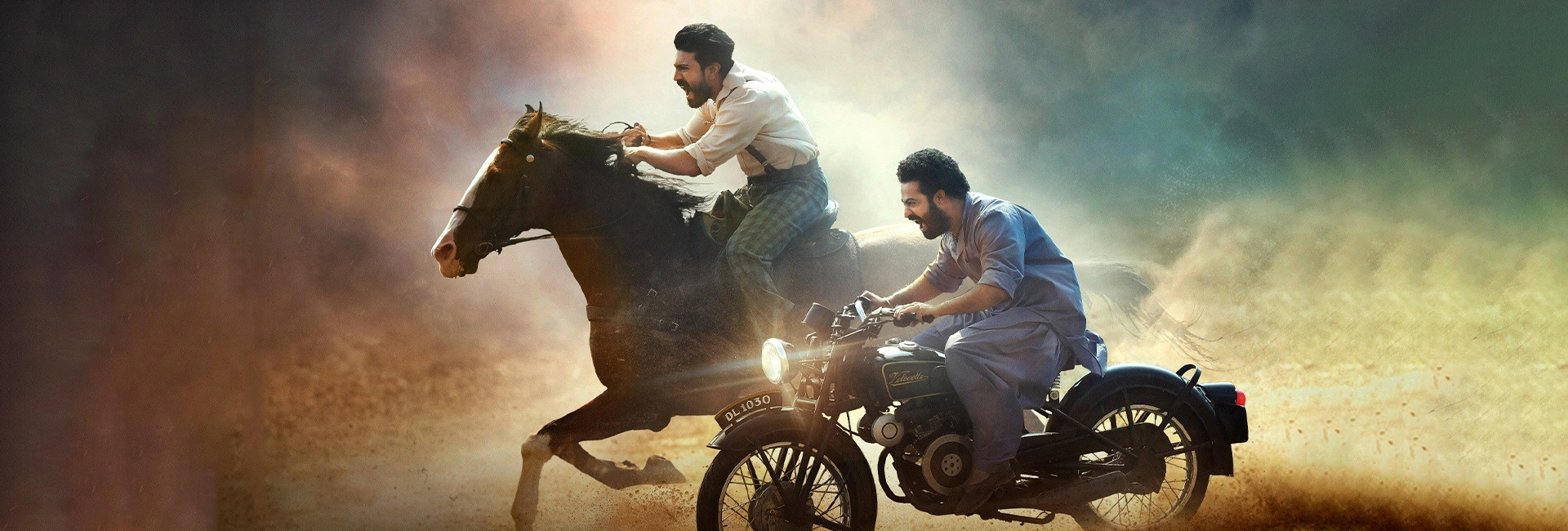(December 20, 2024) It was in the chilly winters of 2016 when I boarded a bus from Tashkent to Chorvoq, a stunning icy blue lake in the Tian Shan mountain range of Uzbekistan. Our guide Ali welcomed us onboard with a smile. Excited to meet a bunch of Indians exploring his homeland, he immediately started playing Awaara Hoon on his phone. “I am a huge fan of Raj Kapoor,” said the young lad, his grin wide and sincere. “I love watching his films. In fact, my entire family loves his films,” he added, brimming with pride. His love and admiration for the legendary actor wasn’t unique — it was part of a much larger cultural legacy in Uzbekistan, one that began decades ago when Indian cinema first made its way into the Soviet Union. It was in 1954 that Awaara was released in Russia.
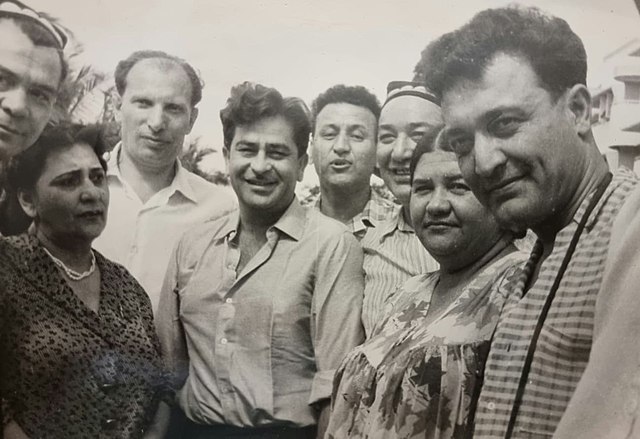
Raj Kapoor
Even after the Soviet Union dissolved and Uzbekistan gained independence in 1991, the love for Raj Kapoor and Indian cinema endured. Ali shared how songs like Mera Joota Hai Japani and Jeena Yahan Marna Yahan still echo in Uzbek homes, at weddings, and even in roadside cafes. “We grew up with these songs,” he said.
A Star Beyond Borders
For Raj Kapoor, 1954 was the year his art crossed borders and touched millions. He was in the Soviet capital to distribute his newly released film Awaara. Translated as Bradgaya for its Russian audience, the film struck an instant chord. The story of a poor underdog — a young man battling society and his fate — mirrored the lives of many post-war Soviet citizens. Awara sold 64 million tickets, making it the third-most watched foreign film in Soviet Russia.
The film was dubbed into Russian so everyone could follow the story. But the songs, including the unforgettable Awaara Hoon, were left in Hindi. It was an unusual choice, but a perfect one. Raj Kapoor’s voice, the emotions in his singing, and the music by Shankar-Jaikishan were enough to move people, even if they didn’t understand the words. Russians hummed along to Hindi lyrics, feeling every note, every beat.
The title song became a national favorite. It wasn’t just a tune — it was hope.
A Timeless Bond
Such was his stardom that when he first landed in Moscow in 1954 without a visa, Soviet Union known for its strict protocols, allowed him to pass through immigration with ease. Late actor Rishi Kapoor once shared a memory about his dad Raj Kapoor’s influence in Russia. “He got outside and waited for a taxi… By then people started recognising that Raj Kapoor is in Moscow. His taxi came and he sat in. Suddenly what he saw was that the taxi is not moving forward and instead is going up. The people took the car on their shoulders.”
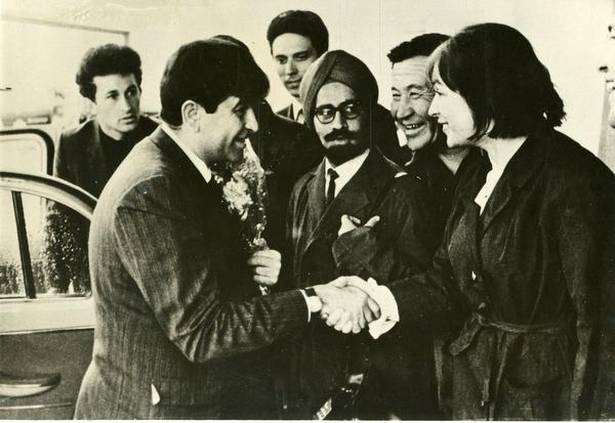
Raj Kapoor in Moscow
For Soviet citizens, Raj Kapoor wasn’t just an actor. He was hope, a reflection of their own struggles, and a symbol of the possibility that happiness could still exist. In his autobiography, Khullam Khulla, Rishi Kapoor said that his dad was a huge star in India but he was a demigod in Russia. ” I witnessed this craze for him when I accompanied him to the Tashkent and Moscow film festivals in ’74, ’76, ’78 and ’80. The Russians treated him like royalty. Elderly women were so overwhelmed to see him in flesh and blood that they wept and kissed his hand. Young men emulated the Raj Kapoor look. Thousands of people lined the street outside his hotel, waiting for a glimpse of him.”
In 1950s Bollywood swiftly entered into the lives of Russians, at a time when India’s relationship with the Soviet Union was flourishing. Prime Minister Jawaharlal Nehru’s refusal to bend to American pressure during the Korean War earned immense respect from the Soviets, who viewed it as a bold and independent stance. But the real turning point came in 1953, when the brutal Soviet dictator Joseph Stalin passed away. His death marked the end of an oppressive era and brought in Nikita Khrushchev, who was far more open to cultural exchanges like foreign cinema. This newfound cultural freedom sparked an appetite for stories from beyond Soviet borders, and it was during this window of opportunity in 1954 that Raj Kapoor introduced Awaara to a ready and receptive socialist audience.
Also, it was a time that Soviet Union was recovering from the devastation of World War II, Stalin’s brutal dictatorship, and an economy in ruins. Life was hard for its citizens. India, too, was battling poverty and rebuilding after centuries of colonial exploitation.
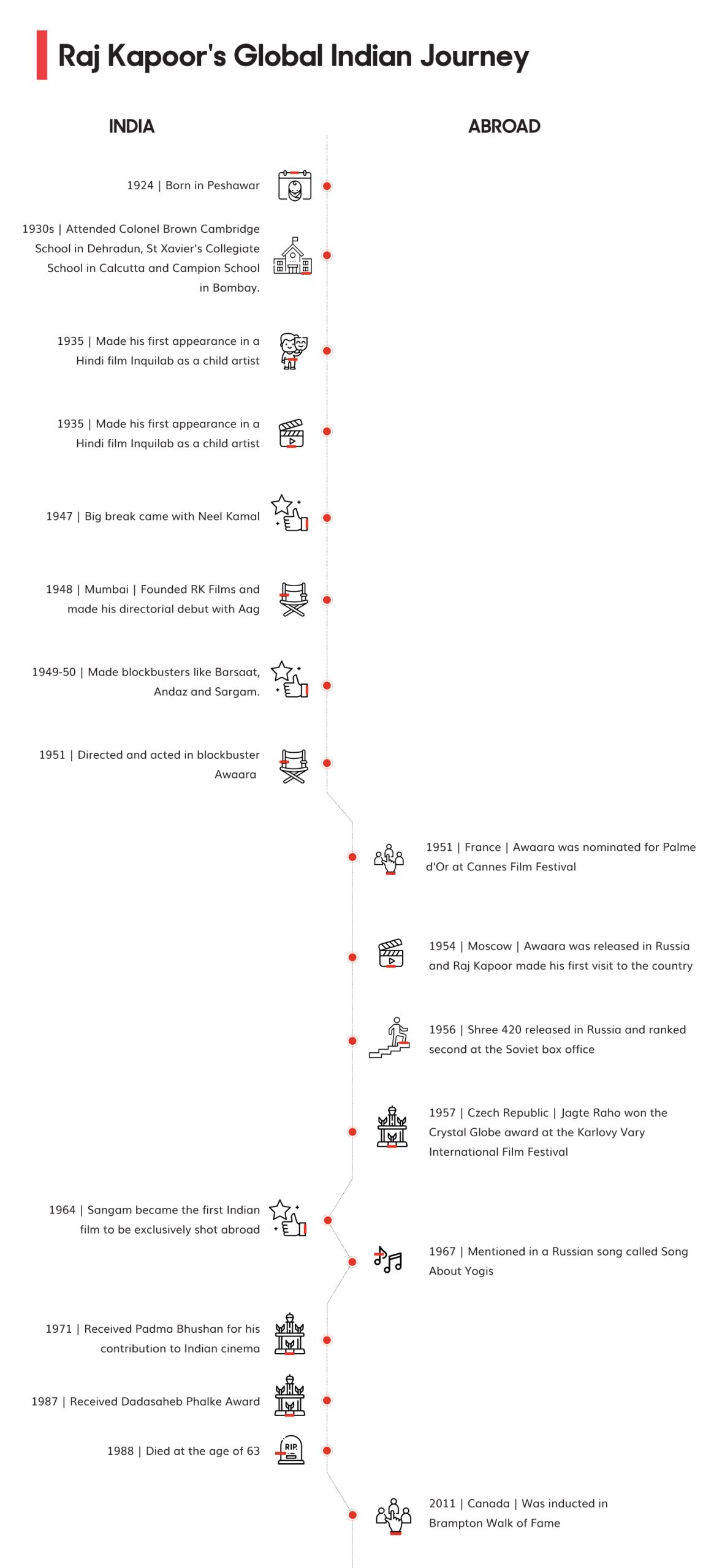
Scriptwriters in both countries reflected these struggles in films. Yet some filmmakers — like Raj Kapoor — chose to go further. His stories gave audiences more than just a mirror of their lives. They offered hope, humor, and a sense of escape from their hardships. People just wanted a break from their worries, even if only for a few hours.
As the bus meandered through snow-dusted roads, Ali’s stories offered a glimpse into a cultural connection that has lasted generations. He spoke of how Indian films brought joy and hope during difficult times and how they continue to be cherished by people of all ages. “Raj Kapoor isn’t just an actor to us,” he said. “He is family.”
A Bond That Endures
The impact of Awara wasn’t fleeting. It opened the floodgates for Indian cinema in the Soviet Union. Kapoor’s later films, like Shree 420 and Sangam, continued to cement his place in Russian hearts. Songs like “Mera joota hai Japani” and “Jeena yahan marna yahan” became household favourites.
Decades later, during Prime Minister Manmohan Singh’s 2011 visit to Moscow, the Kremlin’s Presidential Orchestra paid homage by playing Awaara Hoon. It was a reminder that Raj Kapoor’s magic had not faded.
The Showman of Indian Cinema
Raj Kapoor, born on December 14, 1924, in Peshawar, grew up surrounded by art and performance. As the eldest son of Prithviraj Kapoor, a legend in Indian theatre and cinema, Raj was introduced to the world of films early on. By the age of ten, he made his first screen appearance. After years of small roles, his big break came in 1947 with Neel Kamal. A year later, at just 24, he founded RK Films and directed Aag, launching his journey as a filmmaker.
Known as the “Greatest Showman of Indian Cinema,” Raj Kapoor was deeply inspired by Charlie Chaplin, which showed in his iconic tramp-like characters. Films like Awaara (1951), Shree 420 (1955), and Mera Naam Joker (1970) showcased his unique ability to blend humor, heartbreak, and hope. His stories were rooted in Indian culture but spoke to audiences worldwide, earning him love and recognition across the globe.
The Pioneer of India’s Soft Power
Raj Kapoor’s success in Soviet Russia wasn’t just about box office numbers; it marked the beginning of India’s soft power on a global scale. Long before the term “soft power” became part of diplomatic vocabulary, Kapoor’s films served as a cultural bridge between nations. His stories of struggle, hope, and resilience gave the world a glimpse into the soul of a newly independent India. Recognising his impact, Prime Minister Narendra Modi recently called Raj Kapoor a pioneer of India’s soft power. “In the diplomatic world, we talk a lot about soft power. And at a time when this phrase didn’t even exist, Raj Kapoor sahab established India’s soft power all over the world. It was his big service to India,” PM Modi said while meeting the Kapoor family.
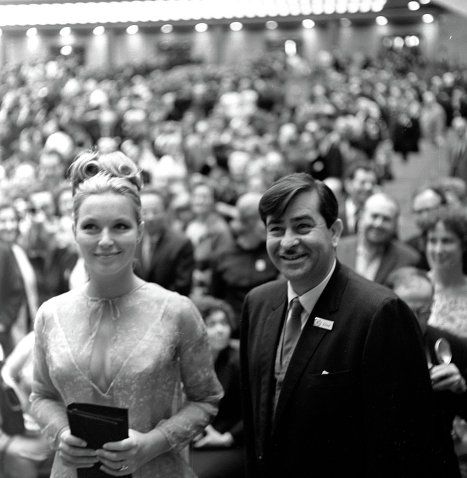
Raj Kapoor at Moscow Film Festival in 1962
In a fitting tribute to the filmmaker’s centenary, Raj Kapoor’s iconic Awaara premiered in 4K resolution (a high-definition video resolution that has four times the number of pixels as 1080p HD video) at the Toronto International Film Festival this September, showcasing the timeless brilliance of his work to a global audience. Films like Awaara and Shree 420 not only won hearts but introduced Indian cinema as a powerful tool of cultural diplomacy, creating connections that transcended borders and politics.
Such was Raj Kapoor’s influence in Soviet culture that in 1967, a Russian singer-songwriter Vladimir Vysotsky highlighted it through his song “Song about Yogis” where he mentioned Raj Kapoor alongside Shiva and yoga as the three most recognised symbols of Indian culture in the Soviet Union. He was truly a Global Indian.
A Timeless Legacy
Even today, shopkeepers in Samarkand call out “Raj Kapoor!” when they see Indian travelers. Across markets, cafes, and homes, his songs still play. The face of the “Showman” — smiling, hopeful, and full of life — remains etched in the hearts of Russians and Uzbeks alike.
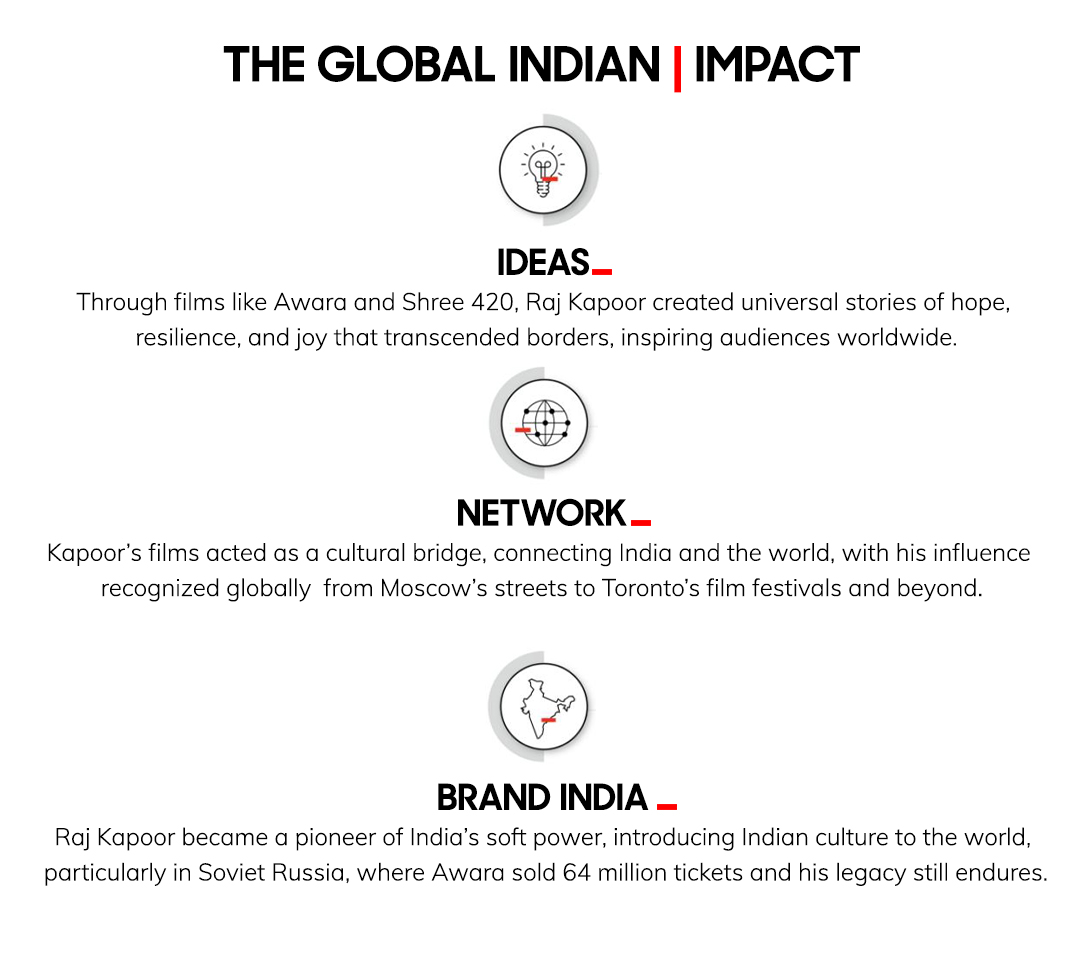
Forever Awaara
On what would have been his 100th birth anniversary, Raj Kapoor’s story continues to inspire. His films brought two nations together — not through politics or treaties, but through art, music, and a shared humanity.
As I stepped off the bus in Chorvoq that day, Ali’s words stayed with me: “Raj Kapoor is our brother.” As Awaara Hoon played softly in the background, it was clear that Raj Kapoor’s legacy lives on — in songs, in stories, and in the hearts of people across the world.



